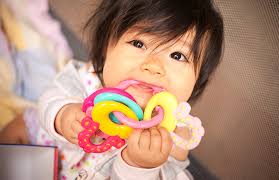
If your baby is teething, it may not be as easy to tell as you would think. Though a baby’s first tooth can erupt as early as three or four months of age, it may also take until their first birthday. By knowing what the signs of teething look like, you know the best ways to help ease your little one’s discomfort. Read on to learn more about the teething timeline, signs to look out for, and how you can help your baby deal with the discomfort.
When Will My Baby’s Teeth Come In?
As we mentioned before, the timeline for when a baby’s teeth begin to come in will vary from child to child. Most infants get their first tooth around six months old, but it’s completely normal if their first pearly white comes in sooner or later than that. The same goes for the rest of their baby teeth. They tend to erupt in a specific order, but the “when” can differ.
The lower front teeth usually come in first, followed by the top front teeth. The teeth on either side of the middle front teeth are usually next with the first molars erupting after that. The canines are next, and the second molars in the very back of the mouth are generally going to be the last teeth to come in.
9 Common Signs of Teething
The teething process is a unique experience for every baby. For this reason, it’s important to know what signs you should look out for. Some indicators that your little one has started teething include:
- Teething rash (dry, chapped, or red skin around the mouth)
- Crying, whining, or being fussy or irritable
- Bringing their hands up to their mouth
- Problems sleeping through the night
- Biting or gnawing on hard objects
- Refusal or reluctance to eat
- Drooling excessively
- Cheek rubbing
- Ear pulling
- Coughing
3 Home Remedies for Teething Pain
Teething can be an uncomfortable process for your baby. Fortunately, there are several ways that you can help ease their symptoms at home, including:
- Teething toys – Chewing can help relieve some of your little one’s discomfort while teething. Consider buying them teething toys or rings to help with the process. You can also let them chew on a soft, wet washcloth or your clean finger.
- Applying cold temperatures –Putting a teething toy in the refrigerator or giving your baby cold foods or drinks can help numb soreness and lessen inflammation.
- Pain relievers –There are pain relievers made specifically for babies that can help ease their discomfort. Make sure to follow the dosing instructions, and consult your little one’s pediatrician beforehand.
Though teething can be uncomfortable for your baby, there are several ways to tell if they’ve entered this stage in their development. By knowing what indicators to look out for, you can help your baby feel more comfortable as they develop a gorgeous grin!
About the Practice
Castle Rock Smiles Pediatric Dentistry takes pride in helping your little ones take good care of their pearly whites. If you’re the parent of an infant who has begun teething, they can offer tips and support to make the process go as smoothly as possible. Soon, your baby will be sporting a beautiful beam! To make an appointment with Castle Rock Smiles Pediatric Dentistry or for more information on their services, call their office at (303) 660-5373 or visit their website.
